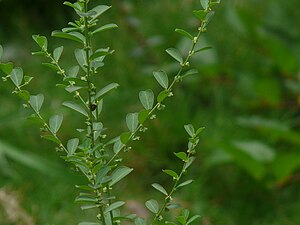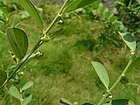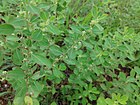Note: This is a project under development. The articles on this wiki are just being initiated and broadly incomplete. You can Help creating new pages.
Phyllanthus maderaspatensis
Phyllanthus maderaspatensis is an erect to spreading, unbranched to much-branched, annual to perennial plant with stems that can become more or less woody and persist for more than a year. It can grow up to 90cm tall, occasionally to 120cm. The plants are harvested from the wild for local use as a medicine. They are traded locally in market places and are also sold for the commercial production of pharmaceutical products.
Contents
- 1 Uses
- 2 Parts Used
- 3 Chemical Composition
- 4 Common names
- 5 Properties
- 6 Habit
- 7 Identification
- 8 List of Ayurvedic medicine in which the herb is used
- 9 Where to get the saplings
- 10 Mode of Propagation
- 11 How to plant/cultivate
- 12 Commonly seen growing in areas
- 13 Photo Gallery
- 14 References
- 15 External Links
Uses
Toothache, Rheumatism, Headache, Bronchitis, Earache, Ophthalmia, Jaundice.
Parts Used
[[:Category:Herbs with used in medicine|]], stem, leaves, Root.
Chemical Composition
It contains n-tetracosane, taraxeryl acetate, ester of β-sitosterol, taraxerol, hexacosane, 32-methyltritriacontanol-1, heptacosanol-14, 11-hydroxyhexacosan-3- one, tetracos-20(cn)-1,18-diol, β-sitosterol and oleana-11,13(18)dienc- 3β,24-diol etc.[1]
Common names
| Language | Common name |
|---|---|
| Kannada | ಮದರಾಸ್ ನೆಲ್ಲಿ Madaraas nelli |
| Hindi | Hajarmani, Kanocha |
| Malayalam | |
| Tamil | Nila-nelli |
| Telugu | Nalla usirika |
| Marathi | Bhuiavali |
| Gujarathi | |
| Punjabi | |
| Kashmiri | |
| Sanskrit | Bhumyaamalaki |
| English | Madras Leaf-Flower |
Properties
Reference: Dravya - Substance, Rasa - Taste, Guna - Qualities, Veerya - Potency, Vipaka - Post-digesion effect, Karma - Pharmacological activity, Prabhava - Therepeutics.
Dravya
Rasa
Guna
Veerya
Vipaka
Karma
Prabhava
Habit
Identification
Leaf
| Kind | Shape | Feature |
|---|---|---|
Flower
| Type | Size | Color and composition | Stamen | More information |
|---|---|---|---|---|
| {{{5}}} |
Fruit
| Type | Size | Mass | Appearance | Seeds | More information |
|---|---|---|---|---|---|
Other features
List of Ayurvedic medicine in which the herb is used
Where to get the saplings
Mode of Propagation
How to plant/cultivate
It grows on a wide variety of soils, usually on heavy clay and alluvial soils of low-altitude river valleys, on river banks and in flood plains.[3]
Commonly seen growing in areas
Deciduous woodland, Wooded savannah, Grassland, On beaches.
Photo Gallery
References
- ↑ Chemical constituents
- ↑ [Morphology]
- ↑ Cultivation
Cite error: <ref> tag with name "Uses" defined in <references> is not used in prior text.
External Links
- Pages with reference errors
- Ayurvedic Herbs known to be helpful to treat Toothache
- Ayurvedic Herbs known to be helpful to treat Rheumatism
- Ayurvedic Herbs known to be helpful to treat Headache
- Ayurvedic Herbs known to be helpful to treat Bronchitis
- Ayurvedic Herbs known to be helpful to treat Earache
- Ayurvedic Herbs known to be helpful to treat Ophthalmia
- Ayurvedic Herbs known to be helpful to treat Jaundice
- Herbs with used in medicine
- Herbs with stem used in medicine
- Herbs with leaves used in medicine
- Herbs with Root used in medicine
- Herbs with common name in Kannada
- Herbs with common name in Hindi
- Herbs with common name in Tamil
- Herbs with common name in Telugu
- Herbs with common name in Marathi
- Herbs with common name in Sanskrit
- Herbs with common name in English
- Habit - Perennial
- Index of Plants which can be propagated by Seeds
- Herbs that are commonly seen in the region of Deciduous woodland
- Herbs that are commonly seen in the region of Wooded savannah
- Herbs that are commonly seen in the region of Grassland
- Herbs that are commonly seen in the region of On beaches
- Herbs
- Pages without herbs images



